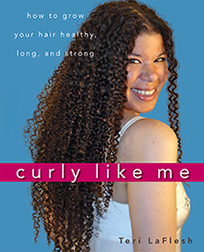
Available now!
Curly Like Me, the off-the-grid, do-it yourself owner's manual for tightly curly hair, is ready for ordering. Grab your copy today!

Every purchase made from
this site (through Amazon)
helps support it — and it
doesn't cost you anything
extra.
|
|
Here are some of the questions I get asked the most, and what my answers have been.
This way you can get your answers immediately, without having to wait on me.
And you never know, you might find answers to a few questions you didn't even know you had yet.
*This is still a work in progress. I'm continuing to add many more questions, and we are still ironing out a few quirks.
But we wanted to make this available as soon as possible.
There are several ways to choose the question(s) you'd like answered:
... or you can ...
... or you can ...
|
|
|
|
|
| |
Question:
Do I need to trim my hair with your method?
Answer:
About trimming your hair with this method: If your hair isn't being damaged any longer, and all of it is healthy, then it doesn't need to be trimmed. Trimming's main purpose is to remove damaged ends. But if you don't have damaged ends, you will just be cutting off perfectly good hair (and potential length). So if you are wanting longer hair, and your ends are healthy, you do not need to trim your hair, ever.
I don't trim mine because it isn't being damaged, and it's grown down to my hips because of it (so I've gone about 12 years without a trim). If, however, your hair has some residual damage (like from flat irons and blow drying), you might want to trim about 1/2 inch a month or 1 inch every two months until the damage is gone. Then you can totally stop trimming. The great thing about following my techniques is that if you follow all of them, you will no longer be damaging your hair. And only damaged hair needs to be trimmed.
But do keep an eye on your ends (another good thing about defining our curls after washing, conditioning, and combing is that every time we go through this process, it gives us a chance to look over our ends to see if any new damage is occurring.)
But do keep an eye on your ends (another good thing about defining our curls after washing, conditioning, and combing is that every time we go through this process, it gives us a chance to look over our ends to see if any new damage is occurring.) With this method, there should be no split ends (unless it was already damaged). If you see lots of split ends, then you do need to keep trimming your hair until you don't see them any longer.
If, however, on your normally healthy ends you suddenly start seeing split ends, it means you just started doing something in your routine that's damaging your hair. Either that, or something slightly damaging you are doing has started adding up, and finally your hair is starting to show the accumulated damage. At that point it's good to think through every single thing you have done to your hair, to be sort of a detective. And remember, there are some things you can do to your hair only once, and you will have damaged it until it grows out again, like flat ironing, rough, dry combing, and especially chemical processes like relaxing or coloring.
|
|
|